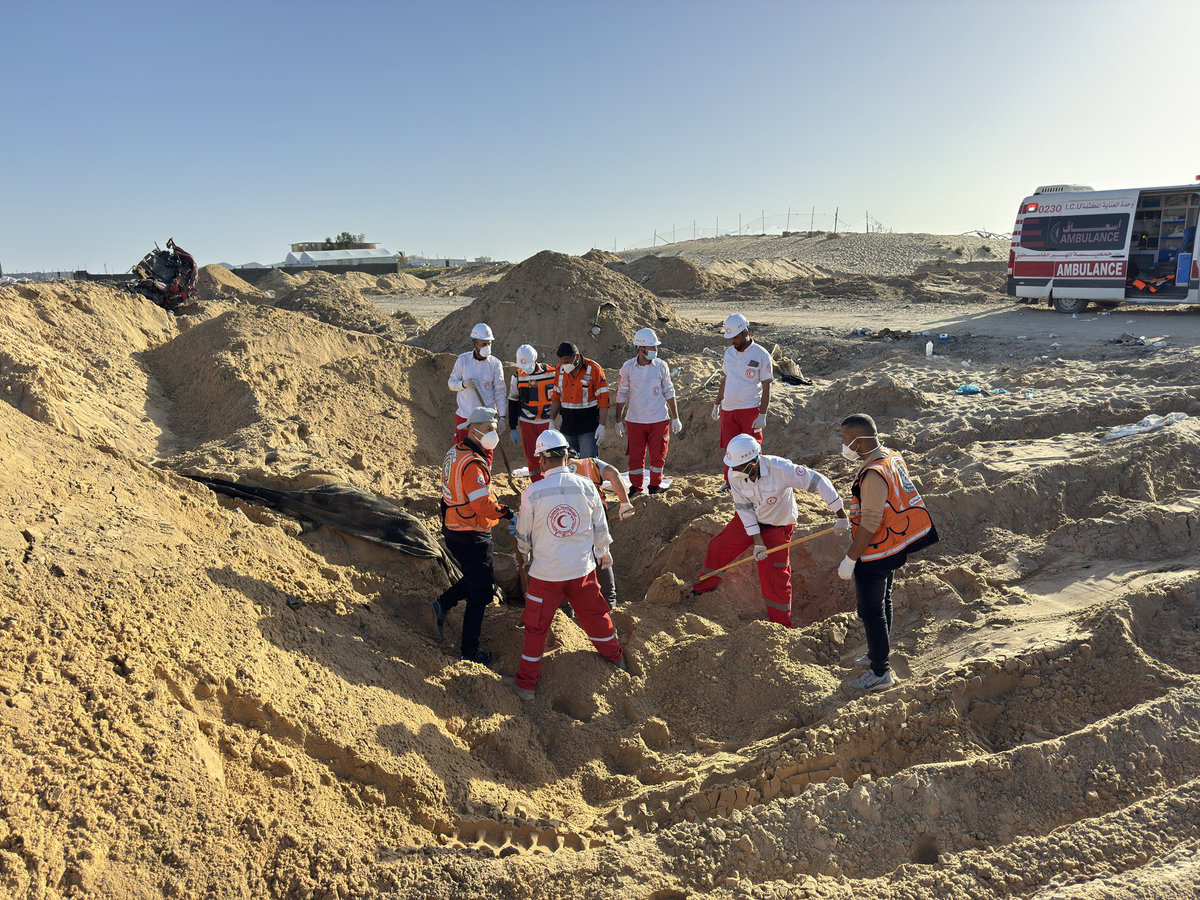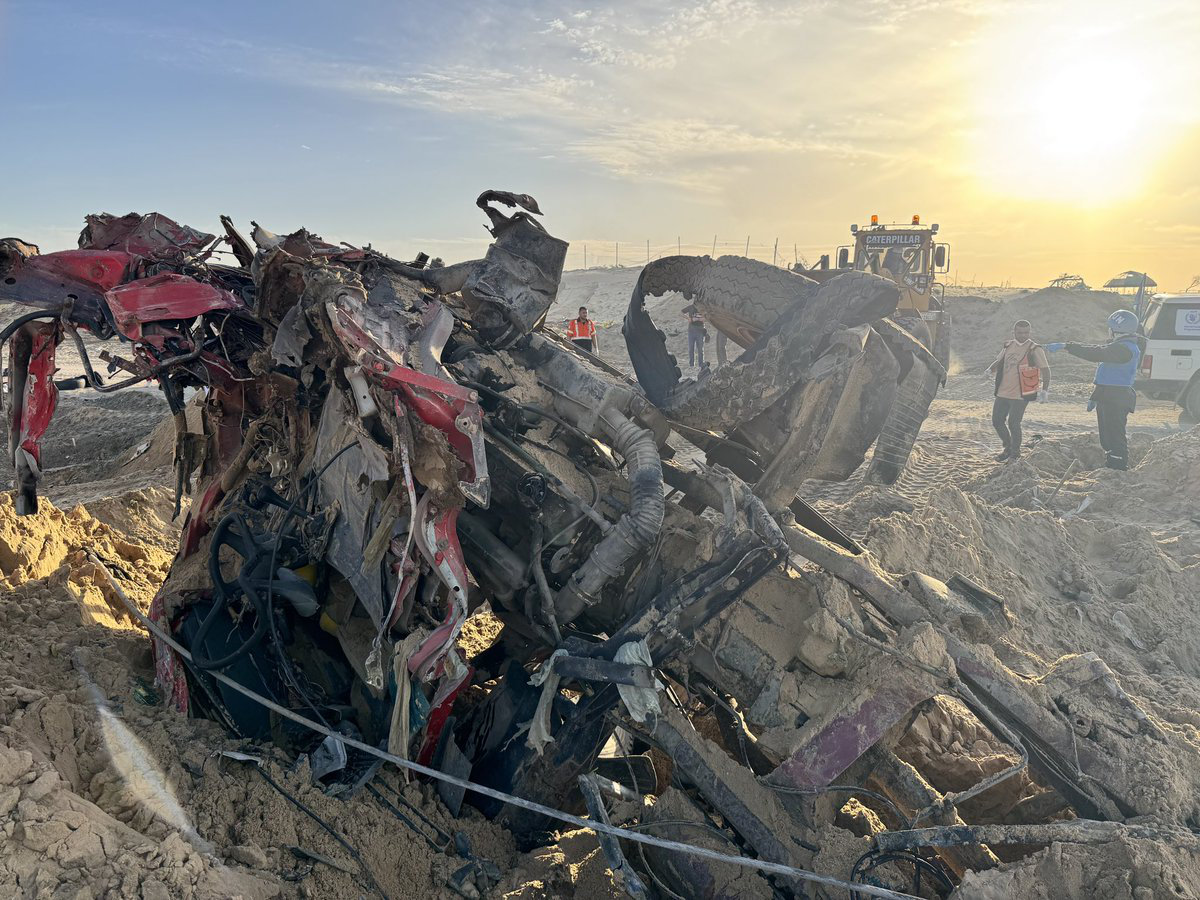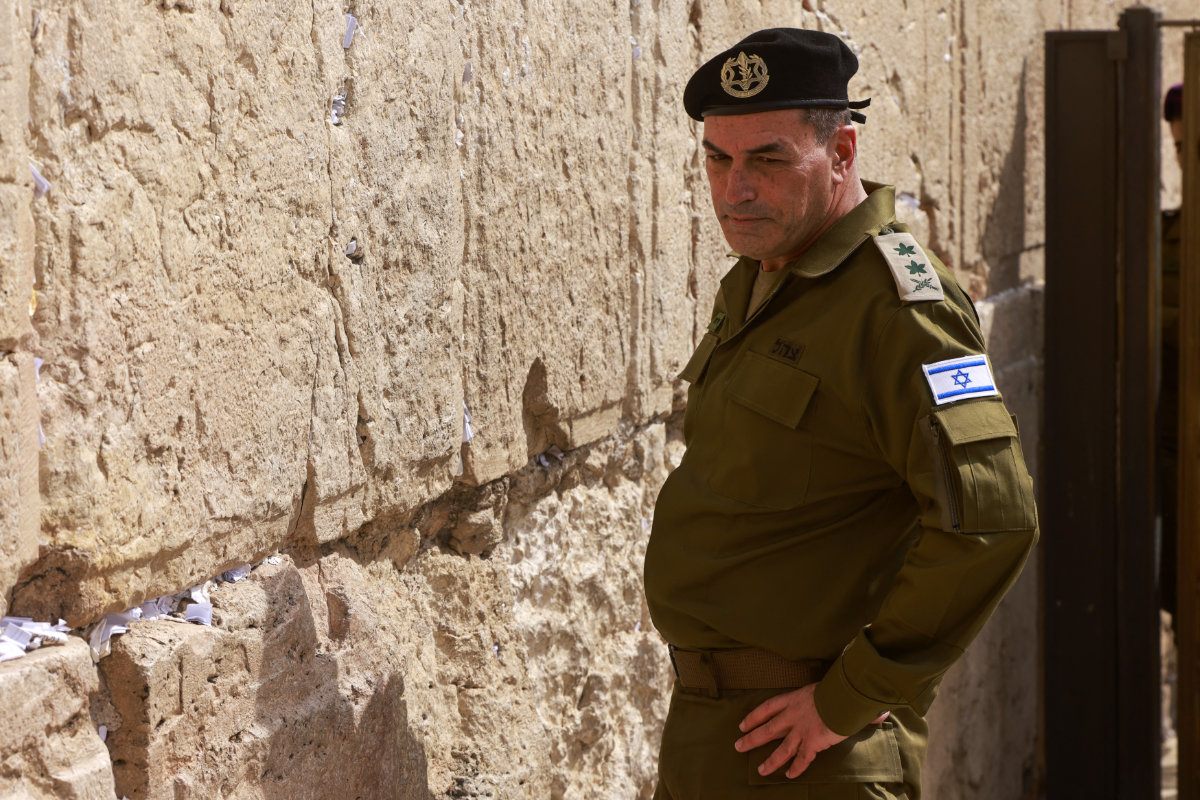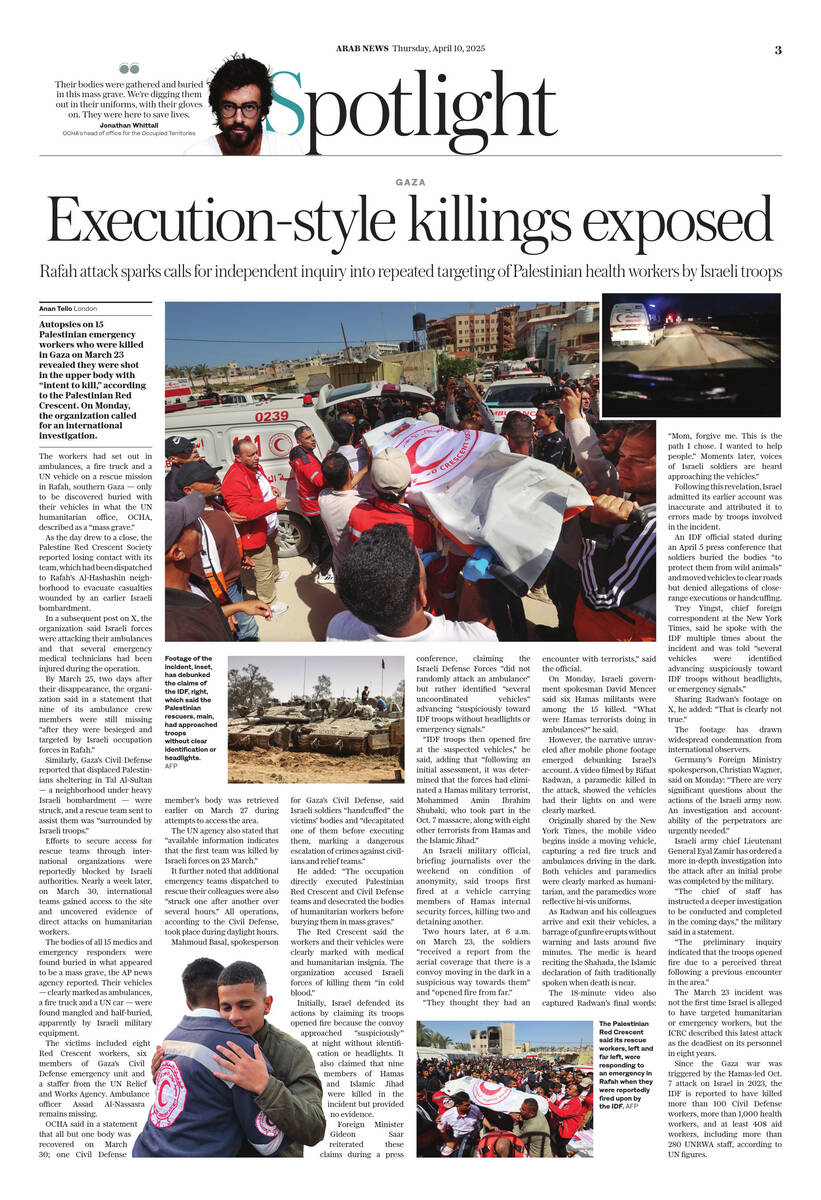LONDON: Autopsies on 15 Palestinian emergency workers who were killed in Gaza on March 23 revealed they were shot in the upper body with “intent to kill,” according to the Palestinian Red Crescent. On Monday, the organization called for an international investigation into the incident.
The workers had set out in ambulances, a fire truck and a UN vehicle on a rescue mission in Rafah in the southern Gaza Strip — only to be discovered buried with their vehicles in what the UN humanitarian office, OCHA, described as a “mass grave.”

International teams led by the UN Office for the Coordination of Humanitarian Affairs (OCHA) dig for bodies of murdered humanitarian workers buried in mass graves by the Israeli military in Gaza. (X: @_jwhittall)
As the day drew to a close, the Palestine Red Crescent Society reported losing contact with its team, which had been dispatched to Rafah’s Al-Hashashin neighborhood to evacuate casualties wounded by an earlier Israeli bombardment.
In a subsequent post on X, the organization said Israeli forces were attacking their ambulances and that several emergency medical technicians had been injured during the operation.
By March 25, two days after their disappearance, the organization said in a statement that nine of its ambulance crew members were still missing “after they were besieged and targeted by Israeli occupation forces in Rafah.”
Similarly, Gaza’s Civil Defense reported that displaced Palestinians sheltering in Tal Al-Sultan — a neighborhood under heavy Israeli bombardment — were struck, and a rescue team sent to assist them was “surrounded by Israeli troops.”
Efforts to secure access for rescue teams through international organizations were reportedly blocked by Israeli authorities. Nearly a week later, on March 30, international teams gained access to the site and uncovered evidence of direct attacks on humanitarian workers.

Contrary to claims by the Israeli military, a video retrieved from the mobile phone of one of the victims showed that the vehicles were clearly marked as ambulances, a fire truck and a UN car. (AFP file photo)
The bodies of all 15 medics and emergency responders were found buried in what appeared to be a mass grave, the AP news agency reported. Their vehicles — clearly marked as ambulances, a fire truck and a UN car — were found mangled and half-buried, apparently by Israeli military equipment.
The victims included eight Red Crescent workers, six members of Gaza’s Civil Defense emergency unit and a staffer from the UN Relief and Works Agency. Ambulance officer Assad Al-Nassasra remains missing.
OCHA said in a statement that all but one body was recovered on March 30; one Civil Defense member’s body was retrieved earlier on March 27 during attempts to access the area.
The UN agency also stated that “available information indicates that the first team was killed by Israeli forces on 23 March.”
It further noted that additional emergency teams dispatched to rescue their colleagues were also “struck one after another over several hours.” All operations, according to the Civil Defense, took place during daylight hours.
Mahmoud Basal, spokesperson for Gaza’s Civil Defense, said Israeli soldiers “handcuffed” the victims’ bodies and “decapitated one of them before executing them, marking a dangerous escalation of crimes against civilians and relief teams.”

"Returning the next day, we were finally able to reach the site and discovered a devastating scene: ambulances, the UN vehicle, and fire truck had been crushed and partially buried," wrote
Jonathan Whittall, OCHA’s head of office for the Occupied Territories, wrote on X. (X: @_jwhittall)
He added: “The occupation directly executed Palestinian Red Crescent and Civil Defense teams and desecrated the bodies of humanitarian workers before burying them in mass graves.”
The Red Crescent said the workers and their vehicles were clearly marked with medical and humanitarian insignia. The organization accused Israeli forces of killing them “in cold blood.”
Initially, Israel defended its actions by claiming its troops opened fire because the convoy approached “suspiciously” at night without identification or headlights. It also claimed that nine members of Hamas and Islamic Jihad were killed in the incident but provided no evidence.
Foreign Minister Gideon Saar reiterated these claims during a press conference, claiming the Israeli Defense Forces “did not randomly attack an ambulance” but rather identified “several uncoordinated vehicles” advancing “suspiciously toward IDF troops without headlights or emergency signals.”
“IDF troops then opened fire at the suspected vehicles,” he said, adding that “following an initial assessment, it was determined that the forces had eliminated a Hamas military terrorist, Mohammed Amin Ibrahim Shubaki, who took part in the Oct. 7 massacre, along with eight other terrorists from Hamas and the Islamic Jihad.”
An Israeli military official, briefing journalists over the weekend on condition of anonymity, said troops first fired at a vehicle carrying members of Hamas internal security forces, killing two and detaining another.
Two hours later, at 6 a.m. on March 23, the soldiers “received a report from the aerial coverage that there is a convoy moving in the dark in a suspicious way towards them” and “opened fire from far.”
“They thought they had an encounter with terrorists,” said the official.
On Monday, Israeli government spokesman David Mencer said six Hamas militants were among the 15 killed. “What were Hamas terrorists doing in ambulances?” he said.
However, the narrative unraveled after mobile phone footage emerged debunking Israel’s account. A video filmed by Rifaat Radwan, a paramedic killed in the attack, showed the vehicles had their lights on and were clearly marked.
Originally shared by the New York Times, the mobile video begins inside a moving vehicle, capturing a red fire truck and ambulances driving in the dark. Both vehicles and paramedics were clearly marked as humanitarian, and the paramedics wore reflective hi-vis uniforms.
As Radwan and his colleagues arrive and exit their vehicles, a barrage of gunfire erupts without warning and lasts around five minutes. The medic is heard reciting the Shahada, the Islamic declaration of faith traditionally spoken when death is near.
The 18-minute video also captured Radwan’s final words: “Mom, forgive me. This is the path I chose. I wanted to help people.” Moments later, voices of Israeli soldiers are heard approaching the vehicles.”
Following this revelation, Israel admitted its earlier account was inaccurate and attributed it to errors made by troops involved in the incident.
An IDF official stated during an April 5 press conference that soldiers buried the bodies “to protect them from wild animals” and moved vehicles to clear roads but denied allegations of close-range executions or handcuffing.
Trey Yingst, chief foreign correspondent at the New York Times, said he spoke with the IDF multiple times about the incident and was told “several vehicles were identified advancing suspiciously toward IDF troops without headlights, or emergency signals.”
Sharing Radwan’s footage on X, he added: “That is clearly not true.”
Likewise, Munther Abed, a surviving paramedic who bore witness to his colleagues’ fate, told the BBC the ambulances had their lights on and denied his colleagues were linked with any militant group.
The IDF promised a “thorough examination” of the incident, saying it wanted to “understand the sequence of events and the handling of the situation.”
The footage has drawn widespread condemnation from international observers. UN human rights chief Volker Turk called for an independent investigation into what he described as apparently systematic killings of emergency workers.
“The subsequent discovery of their bodies eight days later in Rafah, buried near their clearly marked destroyed vehicles, is deeply disturbing,” he said in a statement on April 1. “This raises significant questions with regard to the conduct of the Israeli army during and in the aftermath of the incident.”
Stressing that medical personnel must be protected under international humanitarian law, Turk highlighted significant concerns about Israel’s conduct during and after the incident.
He also noted that the incident took place at a moment when “tens of thousands of Palestinians need help while they are reportedly trapped in Tal Al-Sultan, Rafah, with the entire governorate under a displacement order.”
Likewise, the Palestine Red Crescent and Germany, one of Israel’s closest allies in the EU, called for an urgent investigation into the incident.
Germany’s foreign ministry spokesperson, Christian Wagner, said on Monday: “There are very significant questions about the actions of the Israeli army now. An investigation and accountability of the perpetrators are urgently needed.”
Whether or not a thorough probe is carried out is “a question that ultimately affects the credibility of the Israeli constitutional state,” he added.
Israeli army chief Lieutenant General Eyal Zamir has ordered a more in-depth investigation into the attack after an initial probe was completed by the military.

Israel's newly appointed armed forces chief, Lieutenant General Eyal Zamir, visits the Western Wall in the old city of Jerusalem on March 5, 2025. (AFP)
“The chief of staff has instructed a deeper investigation to be conducted and completed in the coming days,” the military said in a statement.
“The preliminary inquiry indicated that the troops opened fire due to a perceived threat following a previous encounter in the area.”
The March 23 incident was not the first time Israel is alleged to have targeted humanitarian or emergency workers, but the International Federation of Red Cross and Red Crescent Societies described this latest attack as the deadliest on its personnel in eight years.
Since the Gaza war was triggered by the Hamas-led Oct. 7 attack on Israel in 2023, the IDF is reported to have killed more than 100 Civil Defense workers, more than 1,000 health workers, and at least 408 aid workers, including more than 280 UNRWA staff, according to UN figures.

Paramedics transport out of an ambulance some of the bodies of Palestinian first responders, who were killed a week before in Israeli military fire on ambulances, into Nasser Medical Complex in Khan Yunis in the southern Gaza Strip on March 30, 2025. (AFP)
The latest uptick in violence prompted the heads of six UN agencies on Monday to call for an immediate renewal of the ceasefire, which Israel unilaterally broke, and the resumption of humanitarian aid to Gaza, blocked since March 2.
On March 18, Israel renewed its bombardment of Gaza, shattering the fragile ceasefire that had been in place since January. Since then, at least 1,200 Palestinians have been killed in the war-torn enclave, according to local health authorities.
James Elder, spokesperson for the UN children’s agency UNICEF, condemned what he described as “unprecedented breaches” of international humanitarian law linked to the resumption of Israeli air and ground operations in Gaza.
Echoing these concerns, IFRC spokesperson Tommaso Della Longa warned that hospitals “are literally overwhelmed” and running out of medicine and medical equipment. A lack of fuel and damage to infrastructure have knocked “more than half” of the Palestine Red Crescent’s ambulance teams out of action, he added.
The IDF began operations in Gaza in retaliation for the unprecedented Hamas-led attack on southern Israel, which left 1,200 people dead, the majority of them civilians, and saw 240 taken hostage, many of them non-Israelis.
Since then, Israel’s military operations against Hamas and other Palestinian militant groups in the enclave have killed at least 50,800 Palestinians, the majority of them women and children, according to local health officials.
In November, the International Criminal Court issued arrest warrants for Israeli Prime Minister Benjamin Netanyahu and his former defense minister, Yoav Gallant, for war crimes and crimes against humanity in Gaza.
Warrants were also issued for several Hamas officials, who have since been killed in Israeli strikes.
Separately, Israel faces a case at the International Court of Justice, accused of committing genocide, a claim that Israeli officials and their US allies have rejected.



























